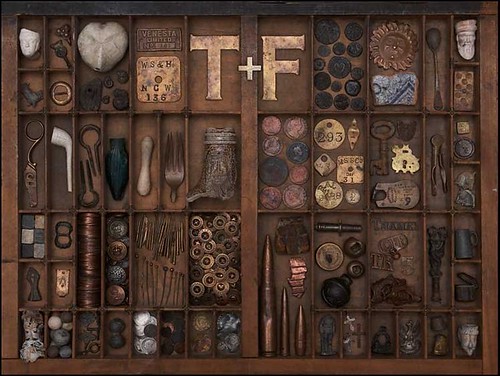
PREV ARTICLE
NEXT ARTICLE
FULL ISSUE
PREV FULL ISSUE
DICK JOHNSON REMINISCES: TYPE DRAWERS AND PRINTING
Dick Johnson submitted these thoughts inspired by an illustration in last week's issue. Thanks!
-Editor

The compartmented tray illustrated in the Thames and Field web site article in last week's E-Sylum looked familiar. It is a type drawer to hold a font of type. It's a California style drawer but it is upside down. As I recall the lower case letter "e" would be were the "F" is located in the illustration. Larger compartments would contain pieces of type (letters) that are used most often and closer to the front. Capital letters and punctuation marks -- the least used -- were in the smallest boxes at back of the tray (shown at the bottom of the illustration). It has been 54 years since I touched such a type tray. As a 15-year-old high school student I purchased a 10 x 15-inch Chandler & Price printing press and taught myself how to print. I bought a cabinet that must have held 100s of drawers as I remember I had 120 fonts of type in a variety of sizes and typefaces. I printed stationery, business cards, play programs for school and even membership cards for the Heart of America Numismatic Association (and other organizations). Two years later I bought the next size larger Chadler & Price press. And more type. Anyone who has set type by hand, locked it in a frame, put the frame in a press, and printed a first impression will know the thrill of seeing your handwork in print. It set me up for a lifetime as a lover of the printed word and related fields of writing and book collecting. But as print shop entrepreneur my venture was short lived. At 18 I was about to be drafted into the Korean War (So I enlisted for four years in the Air Force.) Instead of leaving the infant print shop unattended I sold it intact to a fellow coin collector, James G. McNees. His profession was a photoengraver (so he could make all the "cuts" or "halftones" or illustrations he wanted). Also he had four sons he wanted to teach printing. Jim ultimately started a coin publication -- Coin Collectors Digest -- printed on my old presses. We mentioned that publication previously in The E-Sylum (vol 12, No 1, Art 8, January 4, 2009) But type cases had an ignoble death. Type for any kind of printing (letterpress or offset) could be set by computer at far less expense. Fast forward to 1968. I worked in Midtown Manhattan (at Medallic Art Co on East 45th Street). This was in the center of all the service industries for the advertising agencies on Madison Avenue. These included photographers, art agencies, messenger services and typographers which set type for the ad agencies. I remember one month walking past a multi-story building on 45th Street that contained dozens of type setting houses. In the street was the largest trash containers I had ever seen. They were trashing those type trays, tens of thousands of them. They could sell the type as scrap for the lead and antimony they contained, but those trays had no value. Out they went. I've seen other art montages using old type drawers. But no one could use tens of thousands.
To read the earlier E-Sylum article, see:
FEATURED WEB SITE: THAMES AND FIELD METAL DETECTING SOCIETY
(www.coinbooks.org/esylum_v15n02a27.html)
The Numismatic Bibliomania Society is a non-profit organization promoting numismatic literature. See our web site at coinbooks.org. To submit items for publication in The E-Sylum, write to the Editor at this address: whomren@gmail.com To subscribe go to: https://my.binhost.com/lists/listinfo/esylum All Rights Reserved. NBS Home Page Contact the NBS webmaster 
|